About the Artist
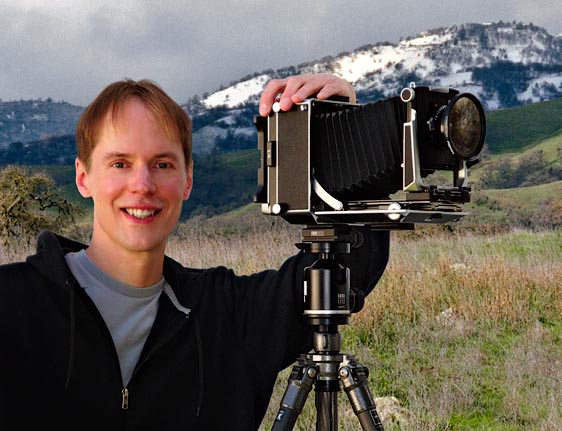
James with his Linhof Master Technika 2000 large format view camera, a Schneider lens, Arca Swiss tripod head, and Gitzo tripod
I approach photography with the goal of recording a scene of natural beauty at a decisive moment so I may then share my experience with the world. I am drawn to beautiful landscapes and prefer to photograph them under extraordinary lighting, weather, or at least a special season. For me a strong composition of an impressive place becomes a compelling photograph only when the timing is perfect too!
My methodology is based in tradition and modern technology. I use an old fashioned large format view camera to make exposures onto big sheets of color print film. This process is contemplative and slow, but the resulting quality is awesome. Whenever possible I adhere to the architectural photography practice of keeping the camera's rear standard vertical while using adjustments to render an undistorted perspective of each scene. Later, I scan the developed negatives and use digital procedures to correct the colors and contrast, making my photographs faithfully convey what I observed in the field. My hybrid analog-capture / digital-processing technique produces images and large photographic prints of stunning clarity and realism.
Surprisingly, my passion for natural landscapes originated in New York City. I grew up there across the street from Forest Park in the town of Richmond Hill, Queens. With its oak and maple woodland, Forest Park is largely undeveloped and offers a glimpse back in time to how Long Island appeared in its natural state. The trees change with the seasons, and the view of the park from our house was a beautiful landscape to behold, right from my window. I was very fortunate to enjoy that scene each day, and have paths and hills to explore and trees to climb while growing up in the big city.
I love beautiful landscapes, landscape paintings, and landscape photography. Since I first discovered him as a teenager, the work of Ansel Adams has awed and inspired me. I was at once moved by the beauty of what he portrayed and by his technical expertise; his photographs exhibit immense richness and sharp detail. More recently I found and quickly grew to admire the work of Galen Rowell. Both of these photographers also wrote a great deal about their work and philosophy, and I have studied their ideas very carefully. Good photography requires planning and thought, and is a much more cerebral pursuit than I originally imagined.
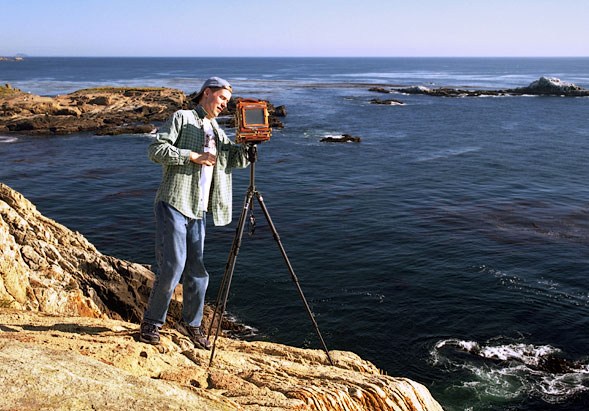
Pt. Lobos, Carmel, CA, Copyright Barry Wright
Photography has always fascinated me; I remember trying to make photographic film out of adhesive tape when I was about five years old. When I was twelve my uncle Russ gave me my first working camera, a Polaroid. A few years later, I began using my late father's Fujica 35mm rangefinder camera and I was very pleased by the sharp colorful photographs I was able to make. My mother majored in Art at school. Her appreciation for fine art and her love of beautiful places transferred directly to me. She pointed out the first colorful sunset I ever saw and encouraged in me the habit of looking for such things. She also taught me the basics of photography and good composition. From her I learned the simple but very important practice of making sure what you see in a camera's viewfinder is the composition you really wish to take home.
I continued to use my father's camera past the end of my school years until I dropped it in the Atlantic Ocean one day while visiting my uncle. The camera never worked after that! I studied Applied Mathematics at Columbia University School of Engineering and Applied Science in New York, and then at the California Institute of Technology in Pasadena, CA. After I drowned the Fujica, my friend Brett Garrett from Caltech gave me his old Nikon F 35mm SLR camera and I happily used that for years. I was impressed by the its ruggedness, ingenious design, and sharp 50mm "normal" lens. I never thought about buying other lenses for the camera until the day I noticed a beautiful distant scene through some trees on a ridge in Yosemite National Park. I realized the scene was too small in the viewfinder, but when I tried to move closer to the subject I had to walk downhill and lost the view I wanted; I needed a longer lens. Years later when I finally started collecting an assortment of lenses, I was surprised to discover that wide angle lenses are generally more useful for landscapes than long lenses. In my one-lens days, I also got by without a light meter. The meter in the Nikon F needed to be repaired, and I left it that way while finely honing my skill at sensing the light in a scene by eye and determining proper exposure by experience. With one lens and no meter I firmly believed in doing the most I could with the least equipment - a noble objective I no longer adhere to.
I fell in love with California and made that my new home while I pursued a career in Software Engineering. I was amazed at the variety of natural scenery in the American west. Back east, the natural flora is quite similar from the valleys to the mountaintops. But I discovered in places like California and Arizona you can be in a hot dry desert valley and - a half hour later - enjoy snowy alpine conditions upon driving to the top of a nearby mountain! Along the way you'll pass through another half dozen microclimates, each with its own flora. The opportunities for sightseeing and photography are endless!
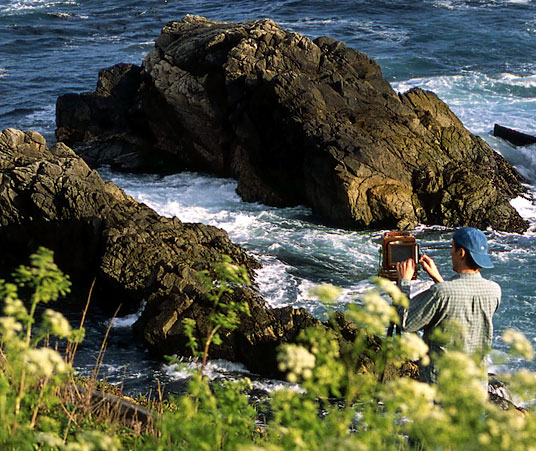
Garrapata SP, Carmel, CA, Copyright Barry Wright
I was perfectly content with my Nikon 35mm camera until another trip to Yosemite in 2005 where I found myself standing next to a photographer who was using a huge 4x5 view camera to record the same beautiful winter scene I was photographing with my little camera. I talked with him and realized that by working just a little harder than me, he would be rewarded with a much higher quality result. I didn't want to buy a digital camera and was intimidated by the thought of using sheet film, so a few months later I put together a Mamiya RZ67 medium format film camera system. Thanks to the Internet and to the fact that such equipment was now going out of style in favor of digital cameras, I was able to buy the equipment at a deep discount. With medium format I saw a nice gain in picture quality and detail, but I was never too happy with the square shape of the photographs; my negatives were now 6x7 cm. The added equipment weight didn't thrill me either, but I was willing to carry all that for the sake of quality.
Around this time I bought my first film scanner and a copy of the Photoshop image processing program by Adobe Systems. What a wonderful world of fine control and artistic possibilities these opened! Before then, I always accepted whatever the camera store did with my negatives as the final word for each photograph I made. Now I began exploring how to free my photos and prints of technical problems and make them communicate the full impact and beauty of the original scenes I witnessed. Of course all this new power brought new demands, requiring me to see my own images more critically, and to develop a tasteful sense for how to improve them. With regard to post-processing and finishing, I have found that each image is an adventure with its own logic and challenges. This - like my work in the field with a camera - is an ongoing and rewarding learning process. By using film to capture a scene and digital processing to finish each image I am able to have the best of both worlds. The two activities are quite complementary; trekking outdoors with camera equipment in all kinds of weather followed by working at a computer in a comfortable darkened room form a varied and satisfying pursuit! Ansel Adams was never fully satisfied with the prints he could make from color film; he was unable to achieve the same level of quality he mastered in his black and white darkroom work. I suspect if the powerful yet delicate control that Photoshop provides for color photography had been available to Adams, he would be remembered today equally for his work in black and white and his color prints.
Only a year after I upgraded to medium format my friend Barry Wright, an abstract painter and professional photographer lent his 4x5 monorail view camera to me. With it I was able to make some nice photographs around the house. Although operating the camera is tricky, I was able to do it and immediately appreciate the enormous resolution and quality such a camera delivers. Shortly thereafter I used the Internet once again to sell my medium format equipment and build a Linhof 4x5 field camera system. Surprisingly, this system weighs less than the medium format system did, while allowing me to use three times as much film per photograph. The high quality I now achieve is a dream come true! The Linhof Master Technika 2000 is my camera of choice for all of my landscape photography. I'm grateful to Barry for encouraging me to make that intimidating but fruitful transition, and for his ideas that have made me more discerning and critical about photography in particular and fine art in general.
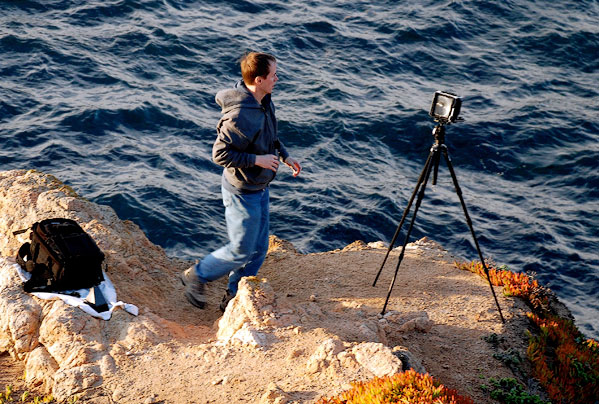
Pt. Lobos, Carmel, CA, Copyright Barry Wright
Recently I have become enamored with the process of building a photograph by combining two or more exposures made on film. A scene containing a large variation in brightness provides a situation that can benefit from a multiple exposure technique called HDRI (High Dynamic Range Imaging). Typically I will make two captures on film of the same scene - the first exposed correctly for a dark foreground, and the second exposed about four stops less for a much brighter sky. Later, I use Photoshop to combine the two exposures into a finished photograph in which the entire scene is rendered in high quality. I use HDRI with restraint. When severely overused the method produces fantastic but imaginary dreamscapes. When slightly overused HDRI can give every area of the image too much activity and contrast; long before the picture becomes unreal or fantastic looking, it loses its center of interest and the original composition is overwhelmed or lost. For the sake of the entire image, I believe there is merit in retaining areas of rich black.
The other situation where my work now benefits from multiple exposures is when the full scene I wish to record is a more extreme rectangle than my film: either a true panorama, or just somewhat taller or wider than usual. In the past I might not have photographed the entire scene, or I might have used a very wide lens to capture it all with the intent of cropping off the undesired portions later. Now I prefer the superior technique of using the best lens to make a series of exposures - each of a part of the scene - while rotating the camera between each exposure. Later, I use Photoshop to combine the exposures into a finished photograph that displays the full composition in very fine resolution and quality. In addition to enabling unprecedented image resolution and detail, this approach liberates the photographer from the shape of his camera's film or digital sensor. The proportions of the scene may dictate the composition instead of the shape of the camera. This is how it should be - a vast creative upgrade over earlier options!
What Makes a Successful Photograph?
Here are my opinions. They apply to landscapes and possibly all photography: A photograph should realistically convey to the viewer what the photographer witnessed and felt. A photo should have a composition that is compelling whether displayed large or small. Here are the necessary elements beginning with the most important:
• Subject should be of interest to people - something beautiful, special, significant, worth photographing, a subject people might want to see. Of course not everyone enjoys the same things. Plenty of people don't appreciate landscape photography; to some a photograph isn't interesting unless people are in it!
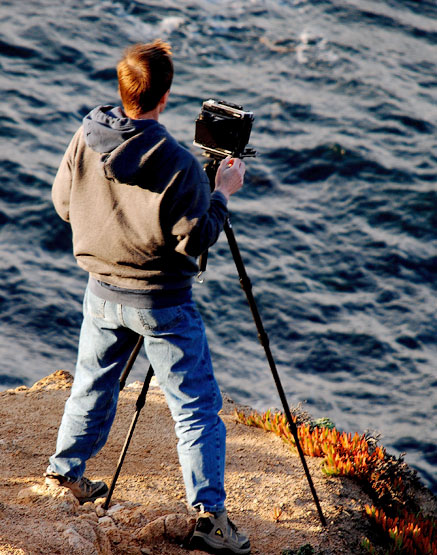
Pt. Lobos, Carmel, CA, Copyright Barry Wright
• Good composition - subject is recognizable, balanced, well arranged, not blocked or obscured, no confusion, no unnecessary distracting extra items, but not over-cropped; a good photograph will provide all needed context. The composition's lines and shapes should create strong visual pathways and a center of interest. That last quality is what makes a photo grab the viewer regardless of the photo's scale or print size.
• Perspective, angle, and point of view are chosen while considering how well-known the subject is - how often it has been photographed before - to determine how much a novel or fresh point of view is called for. Well-known subjects can be photographed with daring & creativity while unusual subjects should be handled conservatively.
• Important items in the scene are the center of interest without too much distraction or busyness from less important objects that are too bright or high in contrast for the overall good of the picture. Both lighting at the time of capture and image post-processing are relevant to achieving this.
• Timing - the photograph should be made at a special time, a decisive moment, interesting weather or season, flattering or unusual circumstances, an instant worth remembering, a moment or occasion that reveals the essence of the subject or shows us something new or unexpected. Unfortunately this often means that the photos we make while on vacation or when just passing through an area don't deliver.
• Good lighting that contributes to all of the above - a photo should portray a scene in flattering light, not too much or too little contrast, allowing the digital sensor or film to do a quality job of recording all the essential elements in the composition.
• Technical competence - the important objects in the scene are in focus, the exposure length is accurate, etc.
What Makes a Successful Photographic Image and Print?
• A full range of luminosities across the image from pure black to pure white (at least in one Red, Green, or Blue channel), with the most important objects in the scene enjoying the most significant portion of that range.
• Strong black plate - the image should have rich satisfying dark areas to provide structure, impact, or drama.
• Appropriate gamma - the image should have overall lighting balance or average lightness that is not too dark or too light. This is somewhat subjective. I strive for realism and what is easy on the eyes.
• Accurate and realistic color - the image should have good color balance with no unwanted color cast. Pleasing color variation and saturation can recreate for the viewer the full visual experience the photographer enjoyed while being at the scene.
• No plugged shadows or blown highlights - both extremes should have adequate detail.
• All three color channels (Red, Green, Blue) should flow smoothly throughout the image without being clipped (staying at the maximum or minimum possible value) in areas that are supposed to have smooth color gradients.
• Sufficiently high resolution with low grain or noise.
Acknowledgments
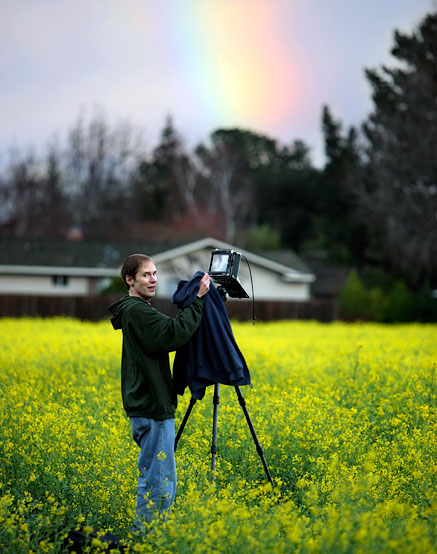
Mountain View, CA, Copyright UPI Photo / Terry Schmitt
Thanks to my mother Edith Mae Snyder for helping me appreciate our beautiful world and for explaining the basics of photography and good composition.
Thanks to her father, my grandfather Harry Charles Volk who was a sculptor and landscape oil painter. When I was in first grade, I decided to make a small watercolor painting of a mountain. Living in New York City and having never seen a mountain, my first attempt rendered the mountain in solid green. Grandpa Harry immediately saw the problem and told me that real mountains - even the green looking ones - are actually many colors when studied carefully. "You'll find every color there is when looking closely at a mountain", he said. Then he showed me how to work all the color paints I had into my mountain painting, and the result was much more realistic. His lesson to me of the importance of color variation helps me with my photography to this day.
Thanks to my uncle Charles Russell Snyder for giving me my first camera.
Thanks to my father Ralph Patrick Snyder for my first 35mm camera. After serving in the U.S. Army my father attended the New York Institute of Photography, hoping to become a professional photographer. Unfortunately that career never materialized. Whenever I go out photographing in beautiful places I feel fortunate and know I am fulfilling his dream, a dream that never came true for him.
Thanks to Ansel Adams and Galen Rowell for their standard-setting photographic works, and for writing books and articles describing their philosophies and methods.
Thanks to landscape photographer John Gavrilis of Aptos, CA for inspiring me with his beautiful work, and for answering my occasional questions at local art shows.
Thanks to "Uncle" Richard Gendron of Long Island for encouraging me to photograph during the first two hours after sunrise and last two hours before sunset so my pictures won't "look the same as everyone else's". I am grateful for this advice, teaching me the importance of timing, weather, and lighting - not just composition! He also stressed the value of occasionally using a polarizing filter.
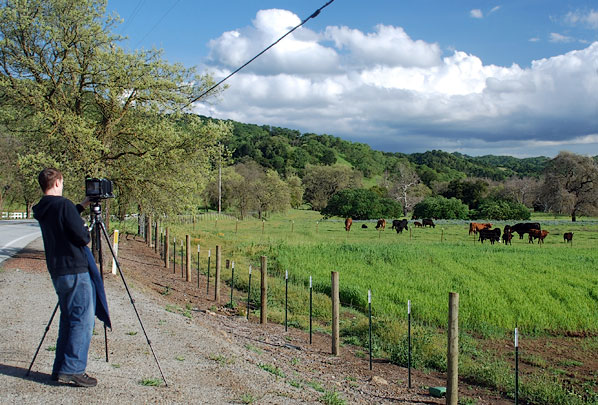
Morgan Hill, CA, Copyright Barry Wright
Thanks to Barry Wright for helping me learn large format photography and for his thoughts on fine art.
Thanks to the writings of Dan Margulis from whom I've learned how to analyze a photographic image to see what can be technically improved and how to accomplish that. He also emphasizes the importance of color variation and offers ways to enhance it!
Thanks to Henry from the photography counter at Lipschutz stationers in Richmond Hill, NY. He used to preview all my prints and offer friendly artistic advice and suggestions.
Thanks to the staff of my favorite camera store Keeble and Shuchat in Palo Alto, CA for all their encouragement and support. In particular I am grateful to Eddie Clark, Barbara Wright, Mike Thomas, Jonathan Parnell, Steve Untalan, Brad Lohmann, and John Clifton.